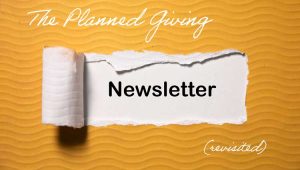
The Illusion of “New” in Planned Giving Marketing
Several times a year, I get emails or phone calls from clients excited about the latest buzz in planned giving marketing. It usually starts with something like this: “Have you seen the new Widget that Company B just launched? It practically guarantees donors will be knocking down our door. My boss thinks we should buy it. Why don’t you offer something like this?” I’ve been in this industry long enough to know what’s coming next. The “Widget” is rarely—if ever—something revolutionary. It’s usually just a repackaging of an existing concept with a fresh coat of paint. A “New” Twist on Old Tools These so-called groundbreaking tools often fall into predictable categories: A “new” planned giving calculator that estimates annuity payments and tax benefits. (Didn’t we already have a dozen of those?) An app for making monthly recurring gifts—essentially a more streamlined version of existing donation platforms. A pre-designed eblast template that’s just a fancier version of what fundraisers have been using for years. The latest online will-maker, promising to revolutionize estate planning with artificial intelligence (but still lacking the personal touch that actually inspires donors to act). At the end of the day, these are just different ways to present the same old concepts. They might have minor tweaks or a sleek user interface, but they don’t change the fundamentals of planned giving. No Magic Bullet for Planned Giving Success Let’s get one thing straight: there is no single product, service, or strategy that will make your planned giving program an overnight success. No widget is going to flood your inbox with eager donors. No new software will miraculously build your endowment. And despite what the latest marketing emails might claim, there’s no “get-rich-quick” formula for growing legacy gifts. What does work? The same things that have always worked: 1. Patience Planned giving is a long game. Unlike major gifts, which often involve donors writing a check today, legacy gifts take years—sometimes decades—to mature. Success comes from planting seeds early and nurturing donor relationships over time. 2. Persistence Consistent messaging, education, and outreach are the real drivers of planned giving success. It’s about staying in front of your donors with thoughtful content and meaningful conversations—not chasing the latest flashy trend. 3. People Skills Donors don’t make legacy gifts because of a new widget. They give because they have a deep emotional connection to your mission. The most effective planned giving programs are built on authentic relationships, trust, and meaningful engagement. Stop Chasing Trends—Focus on What Works The next time you hear about the “latest and greatest” planned giving tool, take a step back. Ask yourself: Does this truly offer something new, or is it just a repackaged version of an old idea? Will it genuinely move the needle on donor engagement, or is it just another shiny object? Is it a tool that strengthens donor relationships, or is it just a gimmick? Planned giving success isn’t about jumping on every new trend. It’s about building a strong foundation through patience, persistence, and people skills. That’s what’s always worked—and it’s what will continue to work, no matter how many new widgets hit the market.
